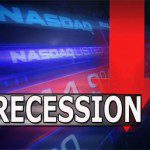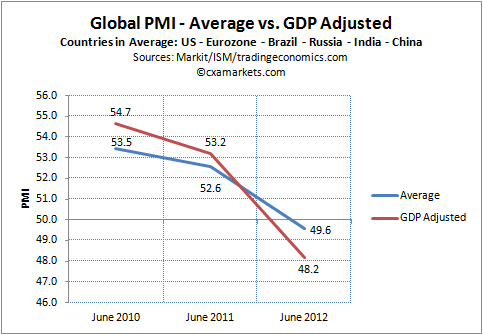 (48.9), the eurozone (46.4), and for 30+ individual countries [Read: Telling It Like It Is: Latest PMIs Reveal Truth About the Global Economy]…and the latest numbers signal contraction and even more so when adjusted to reflect the concentration of GDP by countries/region. [Let me explain.] Words: 600
(48.9), the eurozone (46.4), and for 30+ individual countries [Read: Telling It Like It Is: Latest PMIs Reveal Truth About the Global Economy]…and the latest numbers signal contraction and even more so when adjusted to reflect the concentration of GDP by countries/region. [Let me explain.] Words: 600So says Carlos X. Alexandre (www.cxamarkets.com) in edited excerpts fro his original article* as posted on Seeking Alpha.
Lorimer Wilson, editor of www.munKNEE.com (Your Key to Making Money!), has edited the article below for length and clarity – see Editor’s Note at the bottom of the page. This paragraph must be included in any article re-posting to avoid copyright infringement.
Alexandre goes on to say, in part:
For those who do not know what the PMI numbers mean, they represent a “percentage reporting each response” and the ISM explains further.
A PMI reading above 50 percent indicates that the manufacturing economy is generally expanding; below 50 percent indicates that it is generally declining. A PMI in excess of 42.6 percent, over a period of time, indicates that the overall economy, or gross domestic product (“GDP”), is generally expanding; below 42.6 percent, it is generally declining. The distance from 50 percent or 42.6 percent is indicative of the strength of the expansion or decline.
Global PMI by Major Countries/Region Show Decline
We can say that we are “generally declining,” although we shouldn’t be pulling the fire alarm, yet but we’re still left with country specific readings, and the impact of each individual economy on a global scale varies by size. Thus, the current PMI readings for the U.S., eurozone, and the BRICs were gathered, as well as their respective PMI numbers for the June 2010 and June 2011 periods, producing the following [adjusted] global average:
| June 2012 | June 2011 | June 2010 | GDP ($ billions) | % of Total GDP (US/EU/BRIC) | |
| U.S. | 52.5 | 55.8 | 56.2 | $14,582 | 38.16% |
| eurozone | 46.4 | 52.0 | 55.6 | $12,456 | 32.6% |
| China | 48.2 | 50.1 | 50.4 | $5,879 | 15.38% |
| Brazil | 48.5 | 49.0 | 52.7 | $2,088 | 5.46% |
| Russia | 51.0 | 50.6 | 50.6 | $1,480 | 3.87% |
| India | 55.0 | 58.0 | 55.3 | $1,729 | 4.52% |
| Average | 49.6 | 52.6 | 53.5 | $38,214 (total) |
Global Average PMI Adjusted for GDP Shows Even Greater Decline
What we see is a global decline, but we must consider the sizes of the respective economies, and it was done by gathering the GDPs, adding them up, and calculating the country percentages. For instance, the GDP for the U.S., eurozone and the BRICs combined is $38,214 trillion, and the U.S. represents 38.16% of the total. In addition, the total GDP for the above referenced countries is close to 60% of total global GDP. Then the GDP adjusted PMI averages were calculated by modifying them with the country GDP percentages, and the chart below emerged.

It’s unsettling enough that the average Global PMI has been in decline for two years, but when adjusted for GDP, the negative slope is far more pronounced.
What Does the Future Hold?
We must put the above data in the context of where we have been and, considering that economic stimuli has been applied across the global economic landscape for as long as anyone can remember and the ongoing European debt crisis still lacks a credible resolution, one must only wonder what the future holds.
Take Note: If you like what this site has to offer go here to receive Your Daily Intelligence Report with links to the latest articles posted on munKNEE.com. It’s FREE! An easy “unsubscribe” feature is provided should you decide to cancel at any time.
The BRICs have not turned out to be the lifeguards that the experts had assured us they would be, and it goes without saying that China’s economic troubles – debt and otherwise – are well beyond the percolating stage, although officials have been extremely gracious thus far. As far as equities are concerned, the Financial Times had the perfect headline: “Hopes of stimulus steps support stocks.”
The FTSE All-World equity index sits near to an eight-week high as easing eurozone tensions and hopes for more central bank support counteract recent poor economic data.
Conclusion
Central banks have already flooded the markets with liquidity while governments have amassed debt to feed the economic engines that couldn’t so here we are, with all the monetary and fiscal ammunition used up, and circled by predators without a defense, while looking for sticks and stones to break some recessionary bones.
*http://seekingalpha.com/article/703821-global-recession-probability-increases (To access the above article please copy the URL and paste it into your browser.)
Editor’s Note: The above article may have been edited ([ ]), abridged (…), and reformatted (including the title, some sub-titles and bold/italics emphases) for the sake of clarity and brevity to ensure a fast and easy read. The article’s views and conclusions are unaltered and no personal comments have been included to maintain the integrity of the original article.
Related Article:
1. Telling It Like It Is: Latest PMIs Reveal Truth About the Global Economy
The second half of the year has begun, and…one of the best leading indicators that can shed light on the health of the economy is the purchasing managers index (PMI). The latest local readings of the manufacturing PMI for countries around the world collectively…give investors a critical insight into the pace of economic growth by month [and they can be found below.] Words: 550
 munKNEE.com Your Key to Making Money
munKNEE.com Your Key to Making Money
